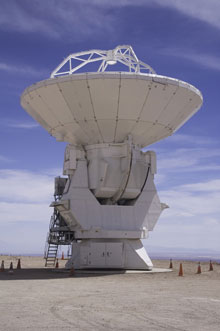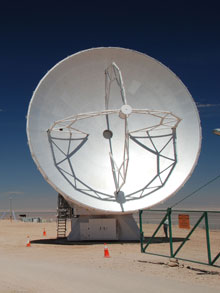December 18, 2008
Contact:
Adrian Russell
North American ALMA Project Director
NRAO
arussell@nrao.edu
Thijs de Graauw
ALMA Director
Joint ALMA Observatory, Chile
tdegraau@alma.cl
John Stoke
North American ALMA Outreach Program Officer
NRAO
+1 (434) 244 6896
jstoke@nrao.edu

The first ALMA antenna to be handed over to the observatory, pictured here at the ALMA Operations Support Facility. This state-of-the-art 12 m diameter antenna was manufactured by Mitsubishi Electric Corporation (Credit: ALMA (ESO/NAOJ/NRAO)).

ALMA 12 m diameter antenna, manufactured by Mitsubishi Electric Corporation, pictured at the ALMA Operations Support Facility (Credit: ALMA (ESO/NAOJ/NRAO)).
ALMA Observatory Equipped with its First Antenna
High in the Atacama region of northern Chile one of the world’s most advanced telescopes has just passed a major milestone. The first of many state-of-the-art antennas has been handed over to the Atacama Large Millimeter/submillimeter Array (ALMA) project.
ALMA is being built by a global partnership whose North American partners are led by the National Radio Astronomy Observatory (NRAO).
With ALMA, astronomers will study the cool Universe, the molecular gas and tiny dust grains from which stars, planetary systems, galaxies and even life are formed. ALMA will provide new, much-needed insights into the formation of stars and planets, and will reveal distant galaxies in the early Universe, which we see as they were over ten billion years ago.
ALMA will initially comprise 66 high-precision antennas, with the option to expand in the future. There will be an array of fifty 12-meter diameter antennas, acting together as a single giant telescope, and a compact array composed of 7-meter and 12-meter antennas.
The first 12-meter antenna to be handed over to the observatory was built by Mitsubishi Electric Corporation for the National Astronomical Observatory of Japan, one of the ALMA partners. It will shortly be joined by North American and European antennas.
“Our Japanese colleagues have produced this state-of-the-art antenna to exacting specifications. We are very excited about the handover because now we can fully equip this antenna for scientific observations,” said Thijs de Graauw, ALMA Director.
Antennas arriving at the ALMA site undergo a series of tests to ensure that they meet the strict requirements of the telescope. The antennas have surfaces accurate to less than the thickness of a human hair, and can be pointed precisely enough to pick out a golf ball at a distance of 9 miles.
“The handover of the first Japanese antenna is the crowning achievement of the ALMA Project to date,” said Adrian Russell, the North American ALMA Project Director at NRAO.
The antenna handover enables the observatory team to proceed with integrating the rest of the components, including the sensitive receivers that will collect the faint cosmic signals from space.
"It marks the start of the next phase of the ALMA project. We have the front-end electronics and back-end electronics inside that antenna and now we can start the push to the high site, to get three antennas joined together interferometrically and start the process of science commissioning," said Russell.
The antennas are tested at the Operations Support Facility, at an altitude of 9,500 feet, before being moved to the plateau of Chajnantor at 16,500 feet, a location where extreme dryness and altitude offer excellent conditions for observing the submillimeter-wavelength light for which the telescope is designed. ALMA's Operations Support Facility will also be the observatory’s control center.
The wide plateau at Chajnantor also offers ample space for the construction of the antenna array, which is spread out and linked together over distances of more than 10 miles.
“The ALMA antennas must withstand the harsh conditions at Chajnantor with strong winds, cold temperatures and a thin atmosphere with half as much oxygen as at sea level. This forbidding environment also poses challenges for the workers building ALMA,” said de Graauw.
The antennas, which each weigh about 100 tons, can be moved to different positions in order to reconfigure the ALMA telescope. This will be carried out by two custom-designed transporters, each of which is some 33 feet wide, 66 feet long, and has 28 wheels.
The ALMA Project is a partnership between the scientific communities of East Asia, Europe and North America with Chile.
ALMA is funded in North America by the U.S. National Science Foundation in cooperation with the National Research Council of Canada and the National Science Council of Taiwan. ALMA construction and operations are led on behalf of North America by the National Radio Astronomy Observatory, which is operated under cooperative agreement by Associated Universities, Inc.
Notes for editors
ALMA will be the leading astronomical instrument for observing the cool Universe — the molecular gas and dust that constitute the building blocks of stars, planetary systems, galaxies and of life itself.
ALMA will operate at wavelengths of 0.3 to 9.6 mm. At these wavelengths, a high, dry site is needed for the telescope to be able to see through the Earth’s atmosphere. This is why ALMA is being built on the 5000 m high plateau of Chajnantor in the Atacama region of Chile. ALMA will offer unprecedented sensitivity and resolution. The 12-meter antennas will have reconfigurable baselines ranging from 15 m to 16 km. Resolutions as fine as 0.005 arcseconds will be achieved at the shortest wavelengths — a factor of ten better than the Hubble Space Telescope.
 Zoom
Zoom